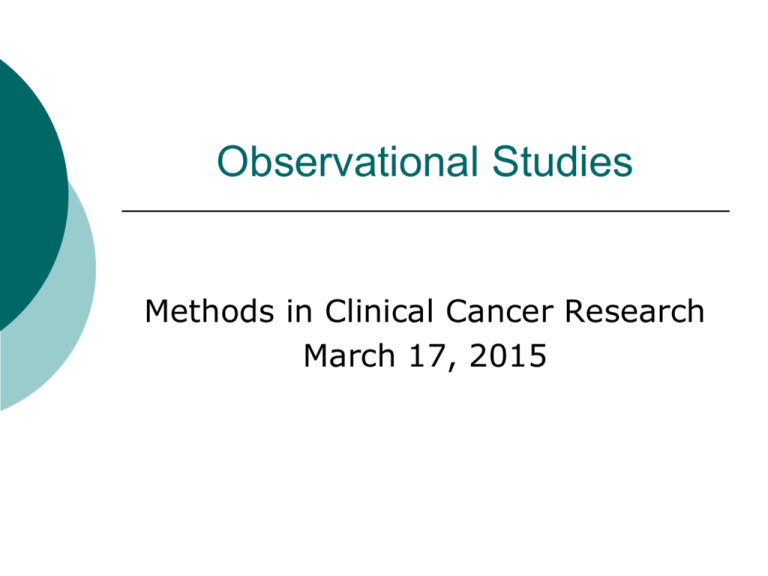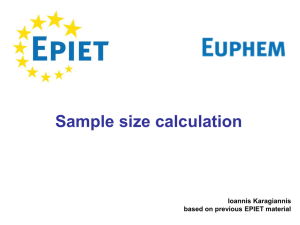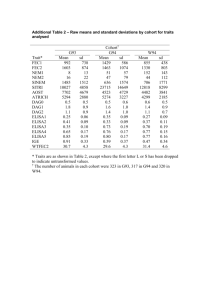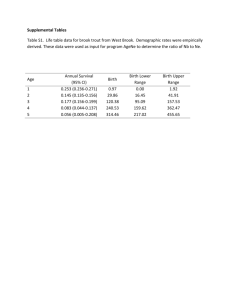Obsnlstudies
advertisement

Observational Studies Methods in Clinical Cancer Research March 17, 2015 Design Types Experimental: Clinical Trials Randomized, sometimes Observational: Prospective Cohort study Retrospective Cohort study “MRR” (Medical Record Review) Case-Control Experimental Designs Exposure/treatments are controlled by design dose levels fixed time course fixed systematic data collection predefined sample size usually randomized if comparative Observational Studies “Sit no “control” over doses, treatments, exposures individuals (patients or doctors) select exposure based on a number of factors back and watch” Generally not based on the flip of a coin. Measurements Exposures Diagnoses Often self-reported Prospective Cohort Studies E.g. Framingham study population followed forward in time assess exposures in the present tense watch for disease in the future usually a “representative”(random) sample, but sometimes sampling is based on exposure goal is to compare exposed and unexposed individuals Case-Control Studies population followed backward in time assess disease status in the present tense look for exposure in the past designed so that sampling is based on disease status goal is to compare diseased and non-diseased individuals Expectation is that cases and controls are comparable How are controls identified? Can any differences be ‘adjusted for’? Designs Prospective Cohort: X D X X D today future Case-Control: X D D X X past today Retrospective cohort study Similar to prospective cohort because sample tends to be “representative” Sampling not based on case/disease status uses historical data (“chart review”) can be treated similarly to prospective cohort study because we are comparing exposed and non-exposed populations Caveat: quality of data is usually not nearly as good as prospective cohort study. Key difference WHO IS BEING COMPARED? COHORT: EXPOSED VS. UNEXPOSED CASE-CONTROL: DISEASED VS. NON-DISEASED Pros & Cons: Prospective cohort vs. case-control Cohort studies are expensive Cohort studies can (usually) measure exposure precisely In cohort studies, disease prevalence can be measured Cohort studies are impractical for study of rare disease. Can assess temporal relationship Case control studies are cheap Case control studies tend to rely on recall for exposure measure Case control studies don’t allow for measurement of disease prevalence Case control studies are efficient in rare diseases Can’t always assess temporal relationship Case-Control and Cohort In both, inferences can be biased due to confounders Confounding would be protected against if we could randomize Both allow for inference when randomized clinical trial would be unethical Smoking? Sun exposure? Measuring Risk Cohort Study: What is the probability of getting diseased if you are exposed as compared to unexposed? Case-Control Study: What is the probability of having been exposed if you have the disease compared to not having the disease? Risk in Cohort Studies Exposed Unexposed Disease A C A+C Non-Diseased B D B+D Relative Risk (RR): probability of disease given exposed probability of disease given unexposed A / ( A B) C / (C D) RR A+B C+D Risk in Cohort Studies Exposed Unexposed Disease A C A+C Non-Diseased B D B+D A+B C+D Odds Ratio (OR): probability of disease given exposed / (1- probability of disease given exposed) probability of disease given unexposed / (1- probability of disease given unexposed) [ A / ( A B )] / [ B / ( A B )] [C / ( C D )] / [ D / ( C D )] A/ B C/D AD BC OR Risk in Case-Control Studies Exposed Unexposed Disease A C A+C Non-Diseased B D B+D A+B C+D Odds Ratio (OR): probability of exposure given disease / (1- probability of exposure given disease) probability of exposure given non - diseased / (1- probability of exposure given non - diseased) [ A / ( A C )] / [C / ( A C )] [ B / ( B D )] / [ D / ( B D )] A/C B/ D AD BC OR Take Home Point Despite difference in design, the odds ratio is the SAME measure of risk in both types of studies. In the simplest analytic approach, we can easily calculate AD/BC from the 2x2 table of an observational study. But, things do tend to get more complicated: what if exposure is not binary? what if we need to adjust for known, measured confounders, such as BMI, smoking, age, parity, etc? Logistic Regression o o o Logistic regression allows us to do 2x2 table analysis, and much more We can account for ‘confounders’ example: o o o Assume BMI is associated with exposure We know BMI is associated with breast cancer risk After adjusting for BMI, is exposure associated with breast cancer? exposure ? BMI Breast cancer Why is logistic regression so important in observational studies? We see it in clinical trials, but it is not as omnipresent as in observational Big difference: in comparative clinical trials, we rely on randomization to ensure comparability of groups. Primary analysis is a simple comparison of, for example, overall survival. Not adjusted Just a plain old HR that assumes randomization balanced groups And, we often use stratification to guarantee balance on key factors (e.g. previously treated vs. newly diagnosed). Why is logistic regression so important in observational studies? In observational studies, individuals self-select treatment/exposure and that choice may be related to other factors. We MUST perform adjustment for confounding factors! Issues: We need to know the confounders We need to have measured the confounders Analogs for time to event endpoints? Cox regression (proportional hazards model) Additive hazards regression Examples 1. Exercise and selenium: what if selenium is strongly associated with prostate cancer? People who exercise tend to eat better diets, rich in selenium. If we consider the association between exercise and prostate cancer without adjusting for selenium, then we may falsely conclude that exercise and prostate cancer are associated. 2. Coffee and lung cancer: A case-control study found a strong association between coffee and lung cancer. However, after adjusting for smoking, the association “went away.” Why? People who self-select smoking also tend to selfselect coffee consumption Confounding Coffee ? Lung Cancer ? ? Smoking Confounding Coffee Lung Cancer Smoking Implications Randomized clinical trials are the “gold standard” Many people don’t put much stock in observational studies But we cant always do randomized trials due to Ethics Costs (time, money, etc.) General feasibility Some observational studies have been enormously informative Framingham Nurses’ Health Study Physicians’ Health Study Olmsted County, Minnesota Recent JCO (Mar 16, 2015) Important: hypothesis-driven! Some are good, but plenty are BAD Clinical trials are designed to detect a clinically meaningful difference In some observational studies, esp. retrospective, the sample size is pre-determined: Based on what is available within a timeframe (e.g. diagnosed with the last 10 years) Based on another scientific question (i.e. this is 2ndary data analysis) Based on yet as determined questions, so the sample size is very large to accommodate rare diseases (e.g. Framingham cohort study) Cautionary remarks When the sample size is arbitrary, P-values should be interpreted with great caution. The study is not appropriately ‘powered’ for a detectable difference. N too large for scientific question? Small p-values may occur but clinical effect size is small. N too small for scientific question? Large p-values may occur, but clinical effect size is large. Focus on effect sizes and 95% confidence intervals Cautionary Remarks Colorectal cancer outcome inequalities: association between population density, race, and socioeconomic status. Rural and Remote Health, 2014. A total of 176 011 patients were identified, with median age 71; Example Article Rebbeck, Troxel, Norman et al. (2007) A retrospective case-control study of the use of hormone-related supplements and association with breast cancer. Int J Cancer, 120, 152328. Study Design: population-based case-control study. 949 cases 1524 controls Disease: breast cancer Exposure: hormone-related supplements Hypothesis Women who have diets rich in phytoestrogens may be at decreased risk of breast cancer. Hormone-related supplements Identification of cases and controls? Cases: identified through active surveillance of 38 hospitals. Controls: “random-digit dialing” in the surrounding counties. Frequency matched on age (+/- 5 years) and race and date of interview (+/- 3 months). Changed from 1:1 ratio to 1:1.6 midway through to increase power Paid for participation? Not mentioned. Demographics 38% of subjects are cases; 62% are controls. Main results: Black Cohosh Footnotes 1. The odds ratio (OR) represents the relationship of herbal exposure and breast cancer risk as estimated from conditional logistic regression matched on age and race, and adjusted for the following variables: (i) education, (ii) age at first full-term pregnancy (iii) menopause status (known natural, assumed natural at reference age of 50 if menopausal status is unknown, and induced), (iv) family history of breast cancer (any vs. none), (v) time from diagnosis/ascertainment to interview, (vi) reference age as a continuous variable and (vii) ever use of hormone replacement therapy. 2. Values within parentheses indicate percentages. 3. Values within square brackets indicate 95% CIs. 4. Odds ratio associations not undertaken due to limited number of women who used this preparation. 1. Most others were not as prevalent 2. all others were in the same direction Power to detect differences? Not mentioned. What is a significant difference? Hypothesis Women who have diets rich in phytoestrogens may be at decreased risk of breast cancer. What about other health habits? Diet? Nutrition? Exercise? These might be related to HRS use Discussion Example of potential pitfalls of observational studies Recursive Partitioning Identifies Patients at High and Low Risk for Ipsilateral Tumor Recurrence After Breast-Conserving Surgery and Radiation. Freedman, Hanlon, Fowble, Anderson, and Nicolaou, JCO, October 2002 PURPOSE: Recursive partitioning analysis (RPA), a method of building decision trees of significant prognostic factors for outcome, was used to determine subgroups at significantly different risk for ipsilateral breast tumor recurrence (IBTR) in early-stage breast cancer. PATIENTS AND METHODS: 912 women underwent breastconserving surgery, axillary dissection, and radiation. Systemic therapy was chemotherapy with or without tamoxifen in 32%, tamoxifen in 27%, or none in 41%. RPA was used to create a decision tree according to predictive variables that classify patients by IBTR risk, and the KaplanMeier method was used to calculate 10-year risks. Median follow-up was 5.9 years. Prediction modeling example Analytic Method: Recursive Partitioning Analysis “Supervised classification” method General ideas of RPA Build a “tree” for diagnostic profiling that can distinguish amongst groups of patients Example: useful for diagnosing based on symptom profiles versus more invasive approach. Useful for predicting survival based on symptom profile Variables are based on their ability to “differentiate” types of patients. In some cases, you might want to differentiate sub-types (e.g. build molecular profiles to differentiate squamous versus adenocarcinoma of the lung) In this case, differentiation is based on length of time to IBTR (survival outcome). How is the tree built? The root node contains the whole sample From there, the tree is the “grown”. The root node is partitioned into two nodes in the next layer using the predictor variable that makes the best separation based on the log rank statistic. This may cause a continuous variable to be dichotomized (e.g. age < 55 versus >55) For each branch, the algorithm then looks for the next variable which creates the broadest separation. The aim is to make the “terminal nodes” (i.e. the nodes which have no offsprings) as homogeneous as possible. When does it stop? It MUST stop if All predictors have the same values for all subjects within a node there is only one observation in each node All subjects in a node have the same outcome “Backward Pruning” Test-statistics can be used to assess which are statistically significant nodes. For example, the log rank statistic can be used to assess whether a split should be “pruned” Zhang et al. (Statistics in Medicine, 1995) examine each tree to see Which splits are superficial? Which splits are scientifically unreasonable? Which splits might require more data? Pruning procedure is NOT completely automatic. It is unclear if any pruning was done in the Freedman article. If it was done, it was not explained and no guidelines for pruning were provided. Prognostic indicators of IBTR: age (as a continuous variable), menopausal status, race, family history, method of detection, presence of EIC, margin status, ER status, number of positive lymph nodes, histology, lobular carcinoma-in-situ (LCIS), use of chemotherapy use of tamoxifen. 5% (1,9) 23% (5,41) 3% (-3,9) 34% 9% (-8,76) (1,17) 20% (10,30) 5% (-1,11) 2% (-2,6) Author’s conclusions CONCLUSION: This RPA showed that age </= 55 versus more than 55 years was the most significant factor for IBTR. Patients </= 35 years old had a low risk of IBTR when tumors were EICnegative with negative margins. EIC was an independent factor for IBTR for ages </= 55 years. Use of tamoxifen was the most significant factor for patients older than 55 years, but it resulted in a greater absolute decrease in risk of IBTR for patients 36 to 55 years old. Problems with this approach Many of age (as a continuous variable), menopausal status, race, family history, margin status, ER status, number of positive lymph nodes, histology, lobular carcinoma-in-situ (LCIS) are known risk factors for IBTR These factors are strongly predictive of whether or not a patient receives tamoxifen and/or chemotherapy. Why? Oncologists will tend to give patients at high risk of recurrence adjuvant treatment. As a result: Low risk women do not receive adjuvant therapy High risk women do receive adjuvant therapy Example High risk women may still tend to have IBTR even in presence of tamoxifen or chemotherapy, but it might still be higher than the rates in the low risk women This could make it appear that adjuvant therapy is related to poor IBTR outcomes! IBTR rate High risk, no therapy High risk, therapy Low risk, no therapy Low risk, therapy 25% 15% 5% 4% Adjuvant therapy is confounded with risk (i.e., those with high risk are more likely to get adjuvant therapy). We are comparing these two groups and concluding that the difference is due to therapy As a result….. Authors conclude that only modest effect is seen from tamoxifen Chemotherapy does not appear in the tree (it is not predictive of outcomes based on the model) For women less then 35, model suggests that chemotherapy and/or tamoxifen do not affect outcomes. Avoiding pitfalls in retrospective analyses Jansen et al. Guidelines were developed for data collection from medical records for us in retrospective analyses., J of Clinical Epi (2005). Conclusion With guidelines for data collection, the quality of research data is enhanced. A well-designed case record form and a handbook for standardized data collection are essential for training the data collectors and for ensuring fastidious searching of the record However, certain kinds of information are not always well documented in patient records. It is essential to perform a pilot study to assess the study design and to use additional questionnaires. “Making the most of chart reviews” Eddy Lang: Mining of Gold instead of Scooping Poop: How to make the most of chart reviews and other retrospective studies. MRR = Medical Record Review “Chart reviews don’t get the respect they deserve” Why? Historical pattern of Wrong questions Poor methods What happened vs. what was documented Missing data Case identification Important data regarding methodology often absent (e.g., abstractor training, std’ized abstraction forms, blinding, etc.). Seven key ingredients of good MRR 1. Abstractor Training: Need to convince the reader that the people pulling the charts are trained Describe the Qualifications and Training procedure for the data Abstractors Before the study begins pull some Trial charts to Test the data abstraction process 2. Case Selection: Needs to be explicit and well described Administrative codes is a start but has flaws Often this can lead to a substudy [i.e do the ultimate codes reflect the Dx?] Clear inclusion/exclusion criteria Screening procedures must be solid 3. Definition of the variables: Need to be done well Dictionary – define things e.g. vitals signs … at triage? by the EP? on reassessment? Timing and Source of the info needs to be described Adjudication – how are you going to categorise contradictions and inconsistencies? Seven key ingredients of good MRR 4. Data Abstraction Tool: Make it good need to have a standardised data abstraction tool – use your research staff here need to have a uniform process of handling missing data – need to think about what to do with missing or unclear data Consider using software to manage data [e.g. Using Redcap] 5. Blinding: Are the abstractors unaware of the study hypothesis? – consider quizzing them afterwards to see. 6. Quality Control regular meetings to ensure standard process need to monitor the abstractors work – consider audits resolution of conflicting assessments 7. Inter-rater reliability: Report inter-rater reliability reported on a sample of charts reviewed by another [blinded] reviewer Observational studies…. Read/interpret them with caution Pore over the methods section. Are the effect sizes meaningful? Are there inherent biases that have not been addressed? They can be done well! They should be hypothesis-driven Data collection methods should be carefully done AND described.





